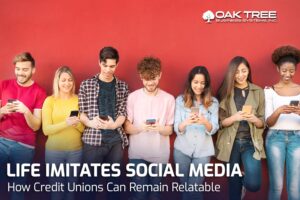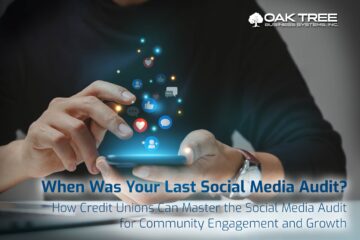How Credit Unions Can Remain Relatable

A whopping seven-in-ten Americans are active on social media. On Facebook alone, 75% of users check their accounts at least once a day. As popular social media platforms like Facebook, Twitter, and LinkedIn are constantly competing for our time, we take a look at how this is affecting CU members and CUs as a whole. It used to be life imitates art was the question, but now it is life imitates social media or vice versa.
Why are we so easily influenced?
In a current generation of cyber babies, most new arrivals are exposed to online content well before the recommended age of 2 years, and at levels that rival adult use. Children are given a smartphone while they eat, while their parents work, and during transport from point A to point B.
By the teenage years (and increasingly earlier), they are creating their digital profile. A fictional character of sorts that molds and evolves based on popular public opinion. Each year, this profile of personal experimentation requires an increasing number of hours to handle the growing number of virtual friends.
As social media takes our filtered selfies and gives them wings, we oddly defy social isolation by in turn craving instant feedback. We morph our social media posts for the audience we want to take notice of. If that avenue fails, there is always another path to stroll down. Unfortunately, it’s this knee-jerk reaction that begins to warp our sense of self and privacy.
We begin to share things online that we wouldn’t share with our close friends and family: secrets, weird habits, things that make us self-conscious… Social media is a license to share, and there are a few limitations.
The rise of the swipe
Perhaps no other social media app gives more of a neurological high than mobile games. These intuitive apps rely on tracking your behavior. Mobile gaming reached 2.2 Billion in 2020 with only 37% of mobile gamers being men, according to TechJury. Besides that, the percentage of adults owning a smartphone from 2011 to 2019 went up by 46%.
And while face-to-face meetings are decreasing, future generations may find more pleasure in swiping on a smart device than actually connecting with their true love in real life.
Understanding the member relationship with social media
So, how do we ensure that we are connected online and still excel via in-person interactions? While having social media accounts fulfill our need to be liked and noticed, we must balance this approval with real-life relationships, or risk losing ourselves in the process.
1. Instant connections
Before there were social media platforms, connecting with a CEO of a large company or a celebrity may have taken many social connections or cold calls. Now you can simply reach out to that person through social media without fear of rejection. Collecting a diverse base of contacts can open up a network of resources, instantly.
Exciting as this newfound freedom is, we can grow a virtual community larger than we can humanly handle.
2. Getting sucked in
Since it’s so easy to start and maintain a virtual relationship, it can be easy to prefer these over in-person meetings. While being active online has its benefits, it is easy not to place enough attention on face-to-face relationships that can stabilize our physical, mental, and emotional health.
3. Overwhelmed emotionally
If someone in your social network has a strong emotion toward you such as loneliness or anger, it is easy to become depressed or distant in our own social media posts. Even though we are participating in a virtual relationship, it can influence our real feelings.
4. Comparison trap
The popular “Like” system on social media has turned into a virtual team-building ritual. While you may not like your friend’s photo, you still may “Like” it, knowing that your friend will return the favor.
Since feedback on social media is instant, it is much easier to form large groups that follow the same opinion. However, social pressures to post frequently and with perfection can cause unnecessary anxiety and loss of an individual’s morals, values, and ultimately, self.
How CUs can relate to their members on social media
It is easy to feel defeated when we are trying to compete with other credit unions and big banks. Social media can exponentiate this feeling and cause us to get off track.
Remember to closely monitor social media messaging and put your members’ problems first. Through the successes and pain points, you can provide genuine transparency to your employees and members, while keeping them at the forefront.
Need a little guidance on how to stay relevant on social media? Check out a few ways credit unions and big banks are staying relatable without compromising their mission.
Think Outside the Box
Find what separates you from your competitors and capitalize on it. The more unique, the more likely your members are to share it.
For example, share posts with behind-the-scenes pics, partnering businesses, or a unique financial tip.
Utilize your employees
Empowering your employees to grow your social media outlets can generate 8 times more engagement than posting from the main credit union handle.
For example, have employees share pictures of themselves along with a few questions that help members get to know your staff better. Have the employees use their own social media accounts to further their reach. Humanizing your credit union can build a sense of community and foster engagement.
Tip: It is important to have social media guidelines when involving your employees. Responses should be polite and clear.
Upgrade your mobile app
Social networking profiles are held by 79% of the U.S. population, according to Statista (2019). As the population continues to gravitate toward using a smartphone rather than a desktop, the focus should be placed on a mobile-friendly solution. Keep up with marketing trends.
Frequently update your accounts
Especially with the state of the world right now, credit unions should be posting on their social media more frequently than ever before. As people are quarantined in their homes, the scroll is what keeps them from spiraling into a black hole of bad news.
Update your operating hours so members don’t have to pick up the phone. If you are getting the same question over and over, post the answer on social media so everyone can benefit. Sprinkle in a few member testimonials.
However, don’t over-post. If it isn’t useful information, you run the risk of over-posting. Overcrowding your account with memes or sales pitches can get old, fast.
Everyone Likes to be Accepted
Although social media removes barriers that would normally impede our social life, at the end of the day we are social creatures who need acceptance. Our local communities are declining in real life, so most people turn to social media to fill that role. It is not just Millennials that your messages need to be sent to.
It is up to credit unions to find the balance between in-person and online interactions to keep communities strong and stay competitive in a volatile financial market. Ask yourself, how does your CU elevate social media?


